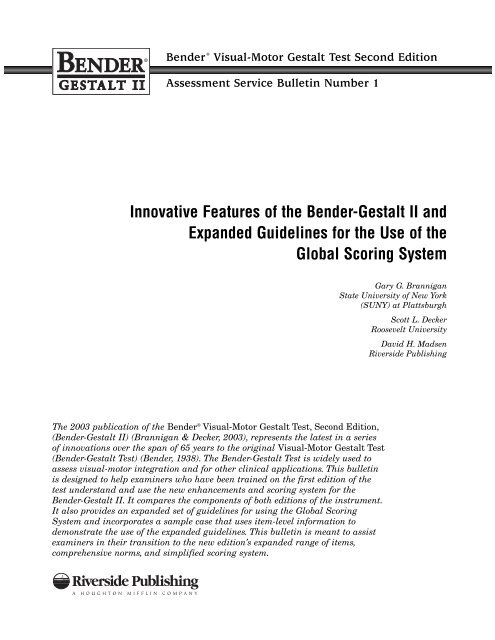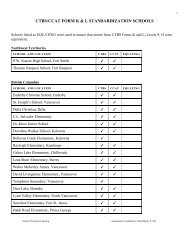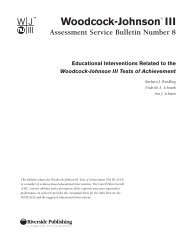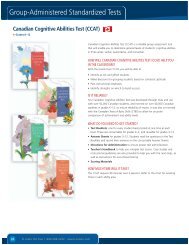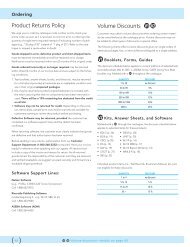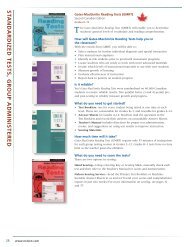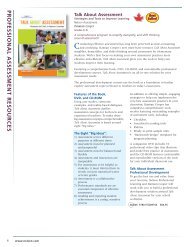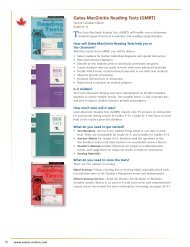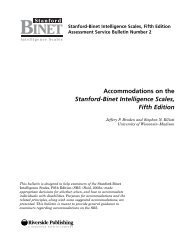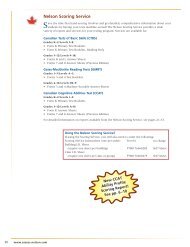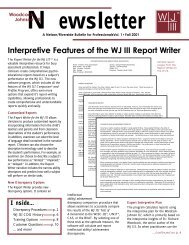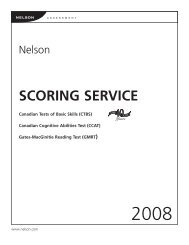Innovative Features of the Bender-Gestalt II and ... - Assessment
Innovative Features of the Bender-Gestalt II and ... - Assessment
Innovative Features of the Bender-Gestalt II and ... - Assessment
You also want an ePaper? Increase the reach of your titles
YUMPU automatically turns print PDFs into web optimized ePapers that Google loves.
9-95644 <strong>Bender</strong> <strong>Gestalt</strong> <strong>II</strong> ASB #1 pg 2 ADP 03/30/04<strong>Bender</strong>-<strong>Gestalt</strong> Test<strong>Bender</strong>-<strong>Gestalt</strong> <strong>II</strong><strong>Bender</strong>’s Scoring SystemNo scoring system is provided, but <strong>Bender</strong>’s (1938)scoring system was referenced. <strong>Bender</strong>’s scoringsystem evaluates <strong>the</strong> overall quality <strong>of</strong> each designon scales ranging from 1 through 5 on one design to1 through 7 on o<strong>the</strong>rs. Descriptions are provided foreach point on <strong>the</strong> scale. The scoring system was notextensively used in clinical practice or research.Several o<strong>the</strong>r scoring systems are currently used.Hutt’s Scoring SystemHutt’s (1945, 1969, 1977, 1985) inspection systememphasizes <strong>the</strong> personality <strong>and</strong> projective uses <strong>of</strong> <strong>the</strong>test in differential diagnosis <strong>of</strong> clinical disorders.The Adience-Abience Scale <strong>and</strong> <strong>the</strong> PsychopathologyScale consist <strong>of</strong> specific factors that are examined toassess <strong>the</strong> degree <strong>of</strong> openness or closeness toperceptual experience <strong>and</strong> <strong>the</strong> degree <strong>of</strong> pathologyexhibited in <strong>the</strong> protocol. The scales evaluate <strong>the</strong>frequency <strong>and</strong> severity <strong>of</strong> deviations in a protocol. Thesystem has been used primarily with adolescent <strong>and</strong>adult populations, although some research suggeststhat it may be appropriate for 10- to 12-year-olds.Lacks’s Scoring SystemLacks’s (1984, 1999) screening system for braindysfunction also employs a clinical inspection methodthat is based on Hutt <strong>and</strong> Briskin’s (1960) twelveessential discriminators <strong>of</strong> intracranial damage. Thesystem, which was designed for adolescents <strong>and</strong>adults, involves examining a protocol for <strong>the</strong> presence<strong>of</strong> each <strong>of</strong> <strong>the</strong> twelve indicants.Koppitz’s Developmental <strong>Bender</strong> ScoringSystemKoppitz developed <strong>the</strong> Developmental <strong>Bender</strong>Scoring System in 1963. It consists <strong>of</strong> 30 discreteerrors that are scored when present. The number <strong>of</strong>errors scored for each design ranges from 2 to 4.The errors selected were thought to be sensitivepredictors <strong>of</strong> school performance, differentiatingbetween students who were ei<strong>the</strong>r above or belowaverage in achievement.Qualitative Scoring SystemThe Qualitative Scoring System (Brannigan & Brunner,1989, 1996, 2002) evaluates <strong>the</strong> accuracy <strong>of</strong> eachdrawing on a 6-point scale ranging from 0 to 5.In addition to providing general guidelines, this systemalso provides specific guidelines <strong>and</strong> examples forscoring each design. It was created to assess <strong>the</strong>overall quality <strong>of</strong> <strong>the</strong> reproductions <strong>of</strong> children fromages 4 years, 6 months to 8 years, 5 months.This scoring system is similar to <strong>the</strong> Global ScoringSystem <strong>and</strong> uses <strong>the</strong> same strict scoring approachthat requires drawings to be “as good as or better than<strong>the</strong> examples at a particular level” to receive credit atthat level.The scoring system was designed to be used with amodified version <strong>of</strong> <strong>the</strong> test (six designs), which ismore appropriate in predicting school achievement inyoung children.Scoring SystemsGlobal Scoring SystemGeneral guidelines <strong>and</strong> specific examples for <strong>the</strong>Global Scoring System are provided for quick, easyscoring <strong>of</strong> subjects’ protocols. The scoring systemevaluates <strong>the</strong> overall quality <strong>of</strong> <strong>the</strong> subjects’reproductions <strong>of</strong> each design on a 5-point scaleranging from 0 (no resemblance, r<strong>and</strong>om drawing,scribbling, lack <strong>of</strong> design) to 4 (nearly perfect).This scoring system is used for evaluating <strong>the</strong>reproductions <strong>of</strong> <strong>the</strong> designs in <strong>the</strong> st<strong>and</strong>ardadministration <strong>of</strong> <strong>the</strong> test (Copy phase) <strong>and</strong> <strong>the</strong>recall <strong>of</strong> <strong>the</strong> designs (Recall phase).2
9-95644 <strong>Bender</strong> <strong>Gestalt</strong> <strong>II</strong> ASB #1 pg 3 ADP 03/30/04<strong>Bender</strong>-<strong>Gestalt</strong> Test<strong>Bender</strong>-<strong>Gestalt</strong> <strong>II</strong>Does not include any supplemental tests.Supplemental TestsProvides a Motor Test <strong>and</strong> a Perception Test to detectdeficits in motor <strong>and</strong>/or perception skills that wouldadversely affect a subject’s visual-motor integrationperformance.Does not include any test record or observation form.Test Record/Observation FormIncludes a comprehensive four-page observation formused to document physical factors that might impede asubject’s performance, test-taking behaviors, <strong>and</strong>specific drawing behaviors as well as to summarizescores on <strong>the</strong> Copy <strong>and</strong> Recall phases <strong>and</strong> <strong>the</strong> Motor<strong>and</strong> Perception Tests.<strong>Bender</strong>-<strong>Gestalt</strong> Test MaterialsIncludes one chart depicting <strong>the</strong> typical reproduction <strong>of</strong>each design for subjects at various ages. Also includesa reference to <strong>Bender</strong> (1938), which provides tables <strong>and</strong>graphs <strong>of</strong> subjects’ design reproductions. Norms werebased on 800 subjects from <strong>the</strong> New York City area.O<strong>the</strong>r Normative Data InformationMore comprehensive normative data are available foro<strong>the</strong>r scoring systems. Hutt’s Psychopathology Scale<strong>and</strong> <strong>the</strong> Adience-Abience Scale were normed ondiverse clinical populations. Means <strong>and</strong> st<strong>and</strong>arddeviations are provided for <strong>the</strong>se populations (e.g.,schizophrenics, neurologically impaired individuals) fordifferential diagnosis.Lacks’s scoring system was also normed on diverseclinical populations. The st<strong>and</strong>ard cut<strong>of</strong>f score fordifferentiating psychiatric patients with <strong>and</strong> withoutneurological impairment is provided.The original normative sample (1963) for Koppitz’sDevelopmental <strong>Bender</strong> Scoring System was based on1,104 children grouped in 6-month age intervals from5 years to 10 years, 11 months. However, <strong>the</strong> samplewas underrepresented, especially geographically <strong>and</strong>racially. There were also wide disparities in <strong>the</strong> number<strong>of</strong> subjects per age group (e.g., one group had27 subjects, while ano<strong>the</strong>r had 180 subjects).The Koppitz scoring system was renormed in 1974(see Koppitz, 1975) to provide a more representativecross-section <strong>of</strong> children. This sample included975 children grouped in 6-month age intervals from5 years to 11 years, 11 months. Still, <strong>the</strong> vast majority<strong>of</strong> subjects were from <strong>the</strong> nor<strong>the</strong>ast (83%) <strong>and</strong> a largepercentage <strong>of</strong> <strong>the</strong>m were white (86%). In addition,large disparities existed in <strong>the</strong> number <strong>of</strong> subjects perage group (8 <strong>of</strong> <strong>the</strong> 13 groupings had fewer than70 subjects, including 3 groups with fewer than50 subjects). Many <strong>of</strong> <strong>the</strong>se age groupings havelow ceilings <strong>and</strong> skewed distributions. Percentilescores <strong>and</strong> age equivalents are provided for eachage grouping.Normative Data <strong>and</strong> Available Scores<strong>Bender</strong>-<strong>Gestalt</strong> <strong>II</strong> Test MaterialsProvides st<strong>and</strong>ard scores, T-scores, percentile ranks,confidence intervals, <strong>and</strong> classification labels for <strong>the</strong>reproductions <strong>of</strong> subjects from 4 to 85+ years <strong>of</strong> age.The test also provides this information for <strong>the</strong> recallperformance <strong>of</strong> subjects 5 to 85+ years <strong>of</strong> age <strong>and</strong>includes percentile scores for raw scores on <strong>the</strong>Motor <strong>and</strong> Perception Tests. Norms are based on astratified, r<strong>and</strong>om sampling that closely matched<strong>the</strong> U.S. census data from <strong>the</strong> year 2000 for sex,race/ethnicity, geographic region, <strong>and</strong> socioeconomiclevel. The sample included 4,000 subjects.3
9-95644 <strong>Bender</strong> <strong>Gestalt</strong> <strong>II</strong> ASB #1 pg 4 ADP 03/30/04<strong>Bender</strong>-<strong>Gestalt</strong> Test<strong>Bender</strong>-<strong>Gestalt</strong> <strong>II</strong>Normative Data <strong>and</strong> Available Scores, continuedBrannigan <strong>and</strong> Brunner’s Qualitative Scoring Systemwas originally normed in 1989 on 994 children groupedin 6-month age intervals. The number <strong>of</strong> subjects ineach grouping ranged from 70 to 168. The sample waspredominantly white <strong>and</strong> from nor<strong>the</strong>astern New Yorkstate. The test was renormed in 1996 on a morenationally <strong>and</strong> racially representative sample, but still itwas not fully consistent with U.S. census data.Each age grouping contained 145 subjects.T-scores <strong>and</strong> percentile scores are provided forage <strong>and</strong> grade groupings.No information was provided on recall performance forany <strong>of</strong> <strong>the</strong>se scoring systems.Exp<strong>and</strong>ed Guidance for Accurately Scoring <strong>the</strong><strong>Bender</strong>-<strong>Gestalt</strong> <strong>II</strong>Although easy to use, <strong>the</strong> Global Scoring System for <strong>the</strong> <strong>Bender</strong>-<strong>Gestalt</strong> <strong>II</strong>requires strict adherence to <strong>the</strong> scoring guidelines <strong>and</strong> examples. To achieve ascore at a particular level, a drawing must be as good as or better than <strong>the</strong>examples at that level. If not, <strong>the</strong> lower score must be assigned. When in doubt,examiners should always give <strong>the</strong> lower score. This policy may be difficult toadhere to at first, because some drawings may have some characteristics <strong>of</strong> <strong>the</strong>scoring examples for <strong>the</strong> higher score. However, <strong>the</strong> complete drawing clearlymust be judged to be as good as or better than <strong>the</strong> examples to get credit atthat level.When using <strong>the</strong> Global Scoring System to score <strong>the</strong> <strong>Bender</strong>-<strong>Gestalt</strong> <strong>II</strong>,examiners may need to shift <strong>the</strong>ir mental set. Older scoring systems, particularlyKoppitz’s Developmental <strong>Bender</strong> Scoring System, are much more lenient; with<strong>the</strong>se systems, errors are not scored unless <strong>the</strong>y are obvious. The Global ScoringSystem is much stricter. To counteract this set, begin at <strong>the</strong> lowest scoring level<strong>and</strong> progress to higher scoring levels when scoring each drawing. Determine if <strong>the</strong>drawing is as good as or better than <strong>the</strong> overall quality <strong>of</strong> <strong>the</strong> four examples. A“yes” response should be obvious <strong>and</strong> quickly determined. If not, <strong>the</strong>re isuncertainty <strong>and</strong> a “no” response is required. The score for <strong>the</strong> drawing should be<strong>the</strong> level at which <strong>the</strong> last “yes” response occurred.Generally, moderate to severe deviations in <strong>the</strong> drawings, includingcharacteristics such as misalignment (rotations), reduction <strong>of</strong> elements (e.g., <strong>the</strong>number <strong>of</strong> dots in Figure 6), increase <strong>of</strong> elements (e.g., <strong>the</strong> number <strong>of</strong> dots inFigure 6), simplification <strong>of</strong> elements (e.g., using lines in Figure 10), omission <strong>of</strong>elements (e.g., a line <strong>of</strong> dots in Figure 10), substitution <strong>of</strong> elements (e.g., drawingdots for circles in Figure 7), <strong>and</strong> integration <strong>of</strong> elements (e.g., not joining <strong>the</strong> circle<strong>and</strong> square in Figure 5), are typically scored in <strong>the</strong> 0 to 2 range, depending on <strong>the</strong>degree <strong>of</strong> severity <strong>and</strong> <strong>the</strong> overall intactness <strong>of</strong> <strong>the</strong> drawings.4
9-95644 <strong>Bender</strong> <strong>Gestalt</strong> <strong>II</strong> ASB #1 pg 5 ADP 03/30/04The Global Scoring System may be more sensitive than o<strong>the</strong>r scoring systemsto visual-motor integration problems. Examiners should be concerned withlow-average performance <strong>and</strong> below (a st<strong>and</strong>ard score <strong>of</strong> 89 or lower), whichindicates that <strong>the</strong> subject is functioning in <strong>the</strong> lowest quartile. The lower <strong>the</strong>score, <strong>the</strong> more confidence can be placed in <strong>the</strong> findings.Because <strong>the</strong> Global Scoring System evaluates <strong>the</strong> overall intactness <strong>of</strong> eachdrawing, factors that are featured prominently in o<strong>the</strong>r scoring systems (e.g.,problems involving distortion, integration, rotation, <strong>and</strong> perseveration) areconsidered in assigning scores.In addition, o<strong>the</strong>r scoring systems can be used with <strong>the</strong> <strong>Bender</strong>-<strong>Gestalt</strong> <strong>II</strong> inseveral ways:1. If all <strong>of</strong> <strong>the</strong> <strong>Bender</strong>-<strong>Gestalt</strong> <strong>II</strong> designs for a particular age group areadministered, <strong>the</strong> relevant designs appropriate to each scoring system canbe evaluated, <strong>and</strong> <strong>the</strong> Global Scoring System <strong>and</strong> o<strong>the</strong>r scoring systems canbe employed.2. If all <strong>of</strong> <strong>the</strong> <strong>Bender</strong>-<strong>Gestalt</strong> <strong>II</strong> designs for a particular age group areadministered <strong>and</strong> considered, <strong>the</strong> Global Scoring System <strong>and</strong> o<strong>the</strong>r scoringsystems can be employed. It is only appropriate to extend <strong>the</strong> Lacks <strong>and</strong>Hutt inspection systems because <strong>the</strong> factors considered are applied moregenerally to <strong>the</strong> evaluation <strong>of</strong> a protocol.3. If only <strong>the</strong> original nine <strong>Bender</strong>-<strong>Gestalt</strong> Test designs are administered, avariety <strong>of</strong> scoring systems can be used. However, <strong>the</strong> Global Scoring Systemcannot be used because <strong>of</strong> incomplete information.Examiners should be cautious when using <strong>the</strong> first <strong>and</strong> second proceduresdescribed above, because <strong>the</strong>se approaches have not been verified by research.However, insights an examiner can gain from using o<strong>the</strong>r scoring methods mayadd greatly to <strong>the</strong> utility <strong>of</strong> <strong>the</strong> Global Scoring System in <strong>the</strong> process <strong>of</strong>differential diagnosis.Common Problems Encountered When Administering <strong>and</strong>Scoring <strong>the</strong> <strong>Bender</strong>-<strong>Gestalt</strong> <strong>II</strong>Administration■■■■■■Miscalculating <strong>the</strong> subject’s ageAdministering <strong>the</strong> incorrect items for <strong>the</strong> subject’s ageAdministering too many itemsAdministering too few itemsAdministering <strong>the</strong> items in <strong>the</strong> incorrect orderRotating or misaligning <strong>the</strong> stimulus cards during administration5
9-95644 <strong>Bender</strong> <strong>Gestalt</strong> <strong>II</strong> ASB #1 pg 6 ADP 03/30/04Scoring■■■■■■■■■Miscalculating <strong>the</strong> subject’s ageIncorrectly calculating <strong>the</strong> subject’s score (summation <strong>of</strong> item values)Scoring based on too many itemsScoring based on too few itemsScoring based on incorrect itemsAssigning scores that are too low (misinterpreting scoring guidelines <strong>and</strong>examples)Assigning scores that are too high (misinterpreting scoring guidelines <strong>and</strong>examples)Reading <strong>the</strong> wrong norm table for <strong>the</strong> subject’s ageConfusing <strong>the</strong> copy <strong>and</strong> recall norm tables<strong>Bender</strong>-<strong>Gestalt</strong> <strong>II</strong> Sample Case With SupplementalInformationThe drawings presented in Figure 1 are for a female child who is 9 years, 6 months<strong>of</strong> age. The examiner scored <strong>the</strong> drawings using <strong>the</strong> Global Scoring System for<strong>the</strong> <strong>Bender</strong>-<strong>Gestalt</strong> <strong>II</strong> <strong>and</strong> <strong>the</strong> Koppitz Scoring System (looking only at <strong>the</strong><strong>Bender</strong>-<strong>Gestalt</strong> Test images [Items 5 through 13 on <strong>the</strong> <strong>Bender</strong>-<strong>Gestalt</strong> <strong>II</strong> cards]).The Beery-Buktenica Developmental Test <strong>of</strong> Visual-Motor Integration–FourthEdition (VMI) (Beery, 1997) was also administered, <strong>and</strong> that score is reported with<strong>the</strong> o<strong>the</strong>r scores at <strong>the</strong> end <strong>of</strong> <strong>the</strong> case.Figures 2 through 13 present <strong>the</strong> <strong>Bender</strong>-<strong>Gestalt</strong> <strong>II</strong> items for <strong>the</strong> sample casein greater detail. Above each figure is <strong>the</strong> <strong>Bender</strong>-<strong>Gestalt</strong> <strong>II</strong> item number <strong>and</strong> arepresentation <strong>of</strong> <strong>the</strong> image that appears on <strong>the</strong> design card. To <strong>the</strong> right <strong>of</strong> orbelow that target image is <strong>the</strong> image that <strong>the</strong> child drew. Below <strong>the</strong> two images isinformation on <strong>the</strong> Global Scoring System item raw score, <strong>the</strong> key points used todetermine <strong>the</strong> <strong>Bender</strong>-<strong>Gestalt</strong> <strong>II</strong> item raw score, <strong>and</strong>, when appropriate, scoringinformation using <strong>the</strong> Koppitz scoring system provided by <strong>the</strong> examiner. Figure 14contains <strong>the</strong> summary information for <strong>the</strong> sample case on <strong>the</strong> GSS <strong>and</strong> Koppitzsystems as well as <strong>the</strong> Beery-Buktenica Developmental Test <strong>of</strong> Visual-MotorIntegration–Fourth Edition (VMI) information.6
9-95644 <strong>Bender</strong> <strong>Gestalt</strong> <strong>II</strong> ASB #1 pg 7 ADP 03/30/04Figure 1<strong>Bender</strong>-<strong>Gestalt</strong> <strong>II</strong> sample case drawings for a female subject age 9 years, 6 months.7
9-95644 <strong>Bender</strong> <strong>Gestalt</strong> <strong>II</strong> ASB #1 pg 8 ADP 03/30/04Item 5<strong>Bender</strong>-<strong>Gestalt</strong> <strong>II</strong> DesignSubject’s DrawingGSS Item Score: 1Key points contributing to GSS Score: Severe distortion, especially integrationKoppitz error information: 2 errors (1a, 3)Figure 2Item 5 Information for <strong>the</strong> <strong>Bender</strong>-<strong>Gestalt</strong> <strong>II</strong> case study.Item 6<strong>Bender</strong>-<strong>Gestalt</strong> <strong>II</strong> DesignSubject’s DrawingGSS Item Score: 2Key points contributing to GSS Score: Moderate distortion, especially spacingKoppitz error information: noneFigure 3Item 6 Information for <strong>the</strong> <strong>Bender</strong>-<strong>Gestalt</strong> <strong>II</strong> case study.8
9-95644 <strong>Bender</strong> <strong>Gestalt</strong> <strong>II</strong> ASB #1 pg 9 ADP 03/30/04Item 7<strong>Bender</strong>-<strong>Gestalt</strong> <strong>II</strong> DesignSubject’s DrawingGSS Item Score: 2Key points contributing to GSS Score: Moderate distortion, especially spacing <strong>and</strong> shapeKoppitz error information: noneFigure 4Item 7 Information for <strong>the</strong> <strong>Bender</strong>-<strong>Gestalt</strong> <strong>II</strong> case study.Item 8<strong>Bender</strong>-<strong>Gestalt</strong> <strong>II</strong> DesignSubject’s DrawingGSS Item Score: 2Key points contributing to GSS Score: Moderate distortion, especially spacing <strong>and</strong> shapeKoppitz error information: noneFigure 5Item 8 Information for <strong>the</strong> <strong>Bender</strong>-<strong>Gestalt</strong> <strong>II</strong> case study.9
9-95644 <strong>Bender</strong> <strong>Gestalt</strong> <strong>II</strong> ASB #1 pg 10 ADP 03/30/04Item 9<strong>Bender</strong>-<strong>Gestalt</strong> <strong>II</strong> DesignSubject’s DrawingGSS Item Score: 1Key points contributing to GSS Score: Severe distortion, especially integration <strong>and</strong> rotationKoppitz error information: 1 error (14)Figure 6Item 9 Information for <strong>the</strong> <strong>Bender</strong>-<strong>Gestalt</strong> <strong>II</strong> case study.Item 10<strong>Bender</strong>-<strong>Gestalt</strong> <strong>II</strong> DesignSubject’s DrawingGSS Item Score: 2Key points contributing to GSS Score: Moderate distortion, especially shapeKoppitz error information: noneFigure 7Item 10 Information for <strong>the</strong> <strong>Bender</strong>-<strong>Gestalt</strong> <strong>II</strong> case study.10
9-95644 <strong>Bender</strong> <strong>Gestalt</strong> <strong>II</strong> ASB #1 pg 11 ADP 03/30/04Item 11<strong>Bender</strong>-<strong>Gestalt</strong> <strong>II</strong> DesignSubject’s DrawingGSS Item Score: 1Key points contributing to GSS Score: Severe distortion, especially shapeKoppitz error information: 2 errors (18a <strong>and</strong> 19)Figure 8Item 11 Information for <strong>the</strong> <strong>Bender</strong>-<strong>Gestalt</strong> <strong>II</strong> case study.11
9-95644 <strong>Bender</strong> <strong>Gestalt</strong> <strong>II</strong> ASB #1 pg 12 ADP 03/30/04Item 12<strong>Bender</strong>-<strong>Gestalt</strong> <strong>II</strong> DesignSubject’s DrawingGSS Item Score: 1Key points contributing to GSS Score: Severe distortion, especially shape <strong>and</strong> integrationKoppitz error information: 4 errors (21a, 21b, 22, <strong>and</strong> 23)Figure 9Item 12 Information for <strong>the</strong> <strong>Bender</strong>-<strong>Gestalt</strong> <strong>II</strong> case study.Item 13<strong>Bender</strong>-<strong>Gestalt</strong> <strong>II</strong> DesignSubject’s DrawingGSS Item Score: 2Key points contributing to GSS Score: Moderate distortion, especially shapeKoppitz error information: 1 error (24)Figure 10Item 13 Information for <strong>the</strong> <strong>Bender</strong>-<strong>Gestalt</strong> <strong>II</strong> case study.12
9-95644 <strong>Bender</strong> <strong>Gestalt</strong> <strong>II</strong> ASB #1 pg 13 ADP 03/30/04Item 14<strong>Bender</strong>-<strong>Gestalt</strong> <strong>II</strong> DesignSubject’s DrawingGSS Item Score: 0Key points contributing to GSS Score: No resemblanceKoppitz error information: N/AFigure 11Item 14 Information for <strong>the</strong> <strong>Bender</strong>-<strong>Gestalt</strong> <strong>II</strong> case study.Item 15<strong>Bender</strong>-<strong>Gestalt</strong> <strong>II</strong> DesignSubject’s DrawingGSS Item Score: 1Key points contributing to GSS Score: Severe distortion, especially shapeKoppitz error information: N/AFigure 12Item 15 Information for <strong>the</strong> <strong>Bender</strong>-<strong>Gestalt</strong> <strong>II</strong> case study.13
9-95644 <strong>Bender</strong> <strong>Gestalt</strong> <strong>II</strong> ASB #1 pg 14 ADP 03/30/04Item 16<strong>Bender</strong>-<strong>Gestalt</strong> <strong>II</strong> DesignSubject’s DrawingGSS Item Score: 0Key points contributing to GSS Score: No resemblanceKoppitz error information: N/AFigure 13Item 16 Information for <strong>the</strong> <strong>Bender</strong>-<strong>Gestalt</strong> <strong>II</strong> case study.<strong>Bender</strong>-<strong>Gestalt</strong> <strong>II</strong> InformationGSS Total Raw Score = 15 St<strong>and</strong>ard Score = 75 Percentile Rank = 4.78Koppitz Error Score = 10Mean <strong>and</strong> St<strong>and</strong>ard Deviation = 2.3+/– 2.1 (Koppitz, 1975, p. 185)Age Equivalent = 5 years, 6 months to 5 years, 8 months (Koppitz, 1975, p. 187)St<strong>and</strong>ard Score (Sattler) = 45 (Sattler, 1992, p. 885)VMI St<strong>and</strong>ard Score = 80All three scores indicate significantly low visual motor integration functioning. However, while <strong>the</strong> GSS for <strong>the</strong> <strong>Bender</strong>-<strong>Gestalt</strong> <strong>II</strong> <strong>and</strong> <strong>the</strong>Beery-Buktenica Developmental Test <strong>of</strong> Visual-Motor Integration–Fourth Edition (VMI) scores are comparable, Koppitz’s Developmental scoreis considerably lower. This discrepancy may be due, at least in part, to <strong>the</strong> age <strong>and</strong> composition <strong>of</strong> <strong>the</strong>se norms, as mentioned previously.Note particularly <strong>the</strong> strict adherence to scoring requirements on <strong>the</strong> GSS—<strong>the</strong> drawing must be as good as or better than <strong>the</strong> examples at aspecific level to get credit at that level. If not, <strong>the</strong> lower score must be assigned. When in doubt, give <strong>the</strong> lower score. (See scoring for designs8, 9, <strong>and</strong> 11.)Figure 14Summary score information for <strong>the</strong> <strong>Bender</strong>-<strong>Gestalt</strong> <strong>II</strong> case study.14
9-95644 <strong>Bender</strong> <strong>Gestalt</strong> <strong>II</strong> ASB #1 pg 15 ADP 03/30/04ReferencesBeery, K. E. (1997). The Beery-Buktenica Developmental Test <strong>of</strong> Visual-MotorIntegration: 4th Edition, Revised. Parsippany, NJ: Modern Curriculum Press.<strong>Bender</strong>, L. (1938). A visual motor gestalt test <strong>and</strong> its clinical use. AmericanOrthopsychiatric Association, Research Monographs (No. 3). New York:American Orthopsychiatric Association.<strong>Bender</strong>, L. (1946). Instructions for <strong>the</strong> use <strong>of</strong> <strong>the</strong> Visual-Motor <strong>Gestalt</strong> Test. NewYork: American Orthopsychiatric Association.Brannigan, G. G., & Brunner, N. A. (1989). The Modified Version <strong>of</strong> <strong>the</strong><strong>Bender</strong>-<strong>Gestalt</strong> Test for Preschool <strong>and</strong> Primary School Children. Br<strong>and</strong>on,VT: Clinical Psychology Publishing.Brannigan, G. G., & Brunner, N. A. (1996). The Modified Version <strong>of</strong> <strong>the</strong><strong>Bender</strong>-<strong>Gestalt</strong> Test for Preschool <strong>and</strong> Primary School Children–Revised.Br<strong>and</strong>on, VT: Clinical Psychology Publishing.Brannigan, G. G., & Brunner, N. A. (2002). Guide to <strong>the</strong> qualitative scoring systemfor <strong>the</strong> Modified Version <strong>of</strong> <strong>the</strong> <strong>Bender</strong>-<strong>Gestalt</strong> Test. Springfield, IL: Thomas.Brannigan, G. G., & Decker, S. L. (2003). <strong>Bender</strong> Visual-Motor <strong>Gestalt</strong> Test, SecondEdition. Itasca, IL: Riverside Publishing.Hutt, M. L. (1945). A tentative guide for <strong>the</strong> administration <strong>and</strong> interpretation <strong>of</strong><strong>the</strong> <strong>Bender</strong>-<strong>Gestalt</strong> Test. U.S. Army Adjutant General’s School.Hutt, M. L. (1969). The Hutt Adaptation <strong>of</strong> <strong>the</strong> <strong>Bender</strong>-<strong>Gestalt</strong> Test (2nd ed.). NewYork: Grune & Stratton.Hutt, M. L. (1977). The Hutt Adaptation <strong>of</strong> <strong>the</strong> <strong>Bender</strong>-<strong>Gestalt</strong> Test (3rd ed.). NewYork: Grune & Stratton.Hutt, M. L. (1985). The Hutt Adaptation <strong>of</strong> <strong>the</strong> <strong>Bender</strong>-<strong>Gestalt</strong> Test (4th ed.). NewYork: Grune & Stratton.Hutt, M. L., & Briskin, G. J. (1960). The clinical use <strong>of</strong> <strong>the</strong> revised <strong>Bender</strong> <strong>Gestalt</strong>Test. New York: Grune & Stratton.Koppitz, E. M. (1963). The <strong>Bender</strong>-<strong>Gestalt</strong> Test for young children. New York:Grune <strong>and</strong> Stratton.Koppitz, E. M. (1975). The <strong>Bender</strong>-<strong>Gestalt</strong> Test for young children (Vol. 2). NewYork: Grune <strong>and</strong> Stratton.Lacks, P. (1984). <strong>Bender</strong>-<strong>Gestalt</strong> screening for brain dysfunction. New York: Wiley.Lacks, P. (1999). <strong>Bender</strong> <strong>Gestalt</strong> screening for brain dysfunction (2nd ed.). NewYork: Wiley.Sattler, J. (1992). <strong>Assessment</strong> <strong>of</strong> Children (3rd ed.). San Diego: Jerome M. Sattler,Publisher Inc.15
9-95644 <strong>Bender</strong> <strong>Gestalt</strong> <strong>II</strong> ASB #1 pg 16 ADP 03/30/04
9-95644 <strong>Bender</strong> <strong>Gestalt</strong> <strong>II</strong> ASB #1 pg 17 ADP 03/30/04
9-95644 <strong>Bender</strong> <strong>Gestalt</strong> <strong>II</strong> ASB #1 pg 18 ADP 03/30/04
9-95644 <strong>Bender</strong> <strong>Gestalt</strong> <strong>II</strong> ASB #1 pg 19 ADP 03/30/04
9-95644 <strong>Bender</strong> <strong>Gestalt</strong> <strong>II</strong> ASB #1 pg 20 ADP 03/30/04
9-95644 <strong>Bender</strong> <strong>Gestalt</strong> <strong>II</strong> ASB #1 pg 21 ADP 03/30/04
9-95644 <strong>Bender</strong> <strong>Gestalt</strong> <strong>II</strong> ASB #1 pg 22 ADP 03/30/04425 Spring Lake DriveItasca, IL 60143-20791.800.323.9540www.riversidepublishing.com9-95644


